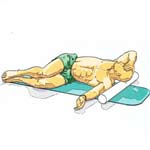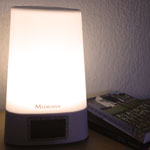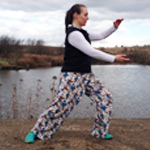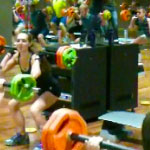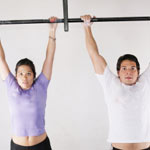Did you know that you can tell quite a few things about your health and wellbeing by monitoring your heart rate?
Today, I will discuss one app that can measure your heart rate that I have found to be useable. You can use it to avoid overtraining and get a warning when the body is not feeling well.
Most of us have forgotten how to read the messages the body sends, so why not use a little technology to help you get back in touch with the signs and symptoms you may be experiencing.
Maybe you have been training exceptionally hard for several months or years, you are feeling fatigued and fed up because all your efforts are not giving you the results you expect to see.
Try one of the methods of tracking for 4 weeks and adapt your training choice each day to what your findings are. You will probably start feeling better quickly and once the body is recovering better you will also be able to get closer to getting results.
Bear in mind that your food choices also affect your results and recovery.
What’s a normal heart rate?
Generally, a lower resting heart rate means your heart is more efficiently circulating blood through your body, which normally indicates that it is a strong and healthy muscle.
If your heart needs more beats per minute to do the same amount of work, over time this can lead to cardiovascular disease and/or heart attacks. A higher resting pulse is usually a sign of overtraining or illness.
Most adults have a resting heart rate of 60-100 beats per minute (bpm).
The fitter you are, the lower your resting heart rate is likely to be e.g. athletes may have a resting heart rate of 40-60 bpm or lower.
You should contact your GP if you think your heart rate is continuously above 120 bpm or below 40 bpm, although this could just be normal for you.
There are a variety of factors can affect your resting heart rate, including the physical size of your heart, body size, activity level, stress level, fitness level, temperature, body position (lying or standing), use of medication and emotions.
During recovery from a workout your metabolism and heart have to work harder to distribute the nutrients and repair your body to get it back to homeostasis. Therefore, if in the morning you have a higher resting heart rate than usual, your body could still be in a state of repair and you should definitely adjust your workout regimen accordingly to prevent over-training or injury.
The app:
How the app works
Instant Heart Rate uses your phone’s camera to detect the pulse from your fingertip.
You wonder how it works?
The instant heart rate app uses the camera feature to read and then average out your heartbeats per minute. Your fingertip changes colour slightly as the capillaries inside expand and contract with each heartbeat. Under bright enough light, these colour changes are easily detected and output to the number on the screen using a simple algorithm.
What the app can do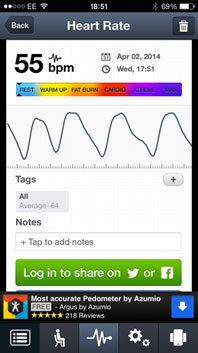
With the FREE version you are able to take your heart rate where ever you are. You get the option to add a note of the situation you were in when taking the measurement. You can choose from pre-set options such as just woken up or exercising or just add your own note. You can set the zone calculations to show based on age.
You can set reminders to take measurements at the same time each day, say you get up at 6:30, you could set a reminder for that time and take your waking resting heart rate to track the bodies fatigue.
With the Paid version you get to store more than the last 5 measurements in your timeline and enables you to turn your phone on its side to see a progress chart of your measurements over time. This is particularly helpful when you are tracking your morning/ waking heart rate to see how well you body is recovering from your workout schedule. If the heart rate goes up from your base line you know that you really need to slow down and spend some time recovering with mindfulness sessions to avoid injuries and ill health.
You can also get hold of the add-on test called StandUp-test.
This test number can be used to give you an understanding of the general strength of your heart. It is based on the Orthostatic heart rate test which is a simple tool you can use to gain insight into how your training program is going and figure out if you are overtraining or under recovering.
Everyone’s body is different. Measuring frequently and tagging results will help you understand which lifestyle changes affect your results. You’ll be able to see how different stressors such as overtraining, dehydration, lack of sleep, work stress, relation ships, heat or cold or some other factors affect your heart rate.
Note: If you have a known or unknown heart condition, or any ailments that affect your heart rate and your body’s physiological response to physical movement, this testing method might not be accurate for you. Note that there are conditions, which inhibit this peak response on the Orthostatic heart rate test, particularly in people with diabetes (Ewing, Hume, Campbell, Murray, Neilson, & Clarke, 1980).
Here is how the StandUp test works:
It is recommend that you establish a baseline for your resting heart rate that you can compare against over time.
To run the base line test, choose a week where you won’t be exercising excessively or pushing your limits. Ideally you would be exposed to limited amounts of stress and generally be feeling well during this test phase.
Every morning for one week do the following:
- Before getting out of bed take your heart rate with the instant heart rate app. Maybe add a note on how you slept.
- Stand up and wait 15 seconds. Measure your standing heart rate with the instant heart rate app, add the note “StandUp test” (this way you won’t need to buy the full app to run the test)
- Now you can see the difference between the lying down in bed and the standing up.

Image courtesy of photostock – FreeDigitalPhotos.net
Write down all 3 numbers:
- Prone/ in bed= 50 bpm
- Standing= 75 bpm
- Orthostatic= 15 bpm (the difference between the in bed and standing measurement)
The average of the Orthostatic number of the 7 day tracking is your baseline.
A typical athletic person has a baseline orthostatic heart rate of about 10-15 BPM.
Your result will vary depending on age, fitness level, etc.
Use the StandUp test to keep track of the effects of your training
Use the Orthostatic measurement to guide you on what training to under take each day.
Now that you have your base line you can compare measurements taken the morning after a particularly hard training session, and then again the next day.
What you will probably see the day after a particularly hard training session is a rise in your orthostatic heart rate as a result of your standing heart rate being higher.
From some experimenting the number can be around 5 beats per minute higher than the normal baseline.
If it is up an active rest day with some mind & body work or a Zone class, Body Flow tai chi or a gentle walk will probably be more appropriate than going to a bootcamp class where you would be exacerbating stress the body is already experiencing.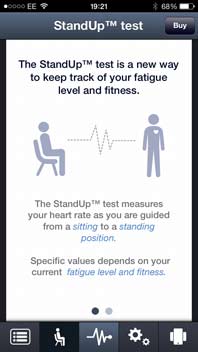
Should that number be even higher, you may be training too hard sacrificing getting results from your training and building a laundry list of overtraining symptoms – check the symptoms list in my last post.
In this case you really should skip the gym all together and just do something fun and soothe the body over with a guided meditation session and some gentle stretching.
Importance of tracking
It is particularly important to take some daily measurements if you are not feeling quite as strong or energised after a prolonged period where you took little time for recovery from your workout schedule, especially if you are showing some of the signs of overtraining.
Remember the body does not get stronger or fitter whilst you are working out. It is when the body has time to recover and respond to the stress you placed on it that it will get stronger and fitter.
You might not believe it but training smart is what gets results not training more.
Listening to your body is essential if you want it to serve you well.
Using this heart rate tracking method can help you see the hard facts until you are able to feel and acknowledge what your body is telling you.
What is going on when the Orthostatic number goes down or approaches zero
You need to watch out for situations where the orthostatic heart rate is way down or approaches zero.
Your body may be shifting into protective mode and putting a serious governor on your heart rate. Your nervous system clamps down on how fast it will let your heart beat. You will probably feel fatigued and your performance won’t be what you are used to. While this may be a single data point, you should not ignore it.
Evaluate how hard you have been training, whether you have been eating enough to sustain a healthy body, what type of stress is occurring in your life, and then make the necessary adjustments to improve your health.
To recap, you can either just take your morning hear rate regularly to see how your body recovers from your workouts or you can go a little further an try the StandUp test and track your Orthostatic number. Both methods can be used as an indicator on how you body is feeling and what type of training you should plan for that day.
My goal today was helping you better understand how your lifestyle habits impact your health, so that you can make informed choices which will promote your health and wellbeing. If you decide to take some measurements, drop me a note and let me know what you find, or leave a comment below.



